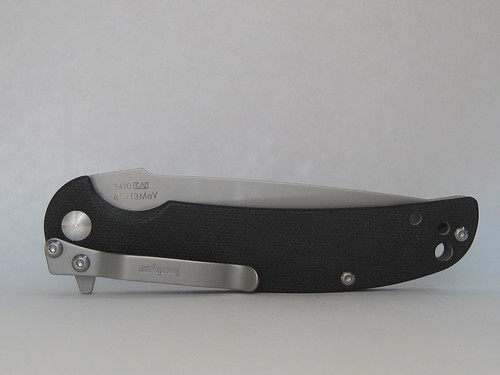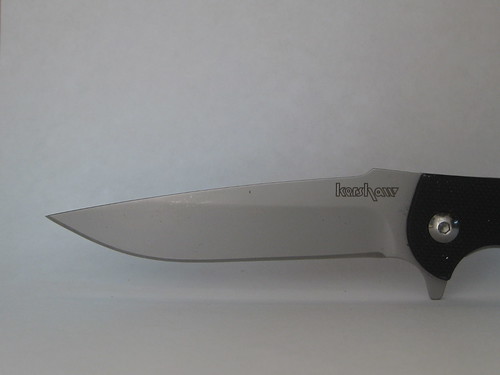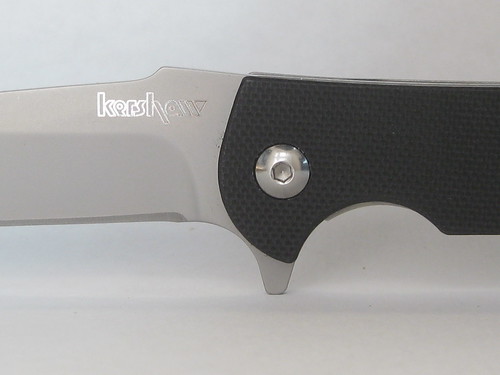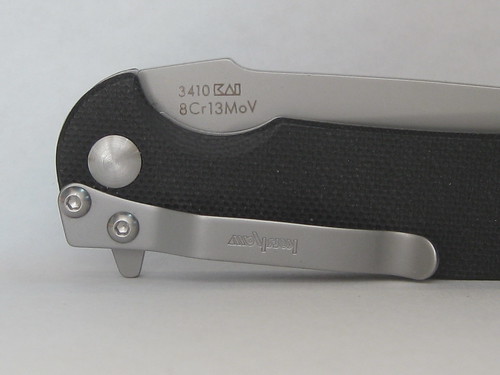Kershaw Chill Review
When you take the work of a custom maker, a high end custom maker, and introduce the design to a line of production knives there are always compromises. If nothing else, you lose the refinement of a hand ground edge. The best production versions of custom knives, things like the ZT560, take the custom bones and add a few features that are better suited to production manufacturing like bearing pivots and 3D CNC machining. The production process giveth and taketh away all at the same time. And in the case of the ZT560 you get a knife that is quite simply excellent. It may not have the exclusivity of an XM-24, but it is a pretty spectacular blade.
But when you take a custom knife and make it a production model AND you drop the budget to entry level, it is always a challenge. The Cryo is a perfect example of a failed conversion. It is a Hinderer design, to be sure, and it has good bones, but the execution is so lacking that the knife is something of a drag on the overall Hinderer brand. I know folks disagree with me and I know there are a lot of them, but: a) this is my site; b) none of them have taken me up on my offer to publish a counterpoint Cryo review using the 20 point system; and c) lots of people thought the world was flat too and that didn't turn out so well for them.
When I saw that one of my favorite custom makers, RJ Martin (read a bit more about Martin here in the Zing review), had designed an ultra budget knife I was worried. My soaring expectations for the Cryo made its ultimate failure that much harder to take. So I tempered my expectations and hoped for the best when I got the Chill from Blade HQ. The Chill arrived and I was surprised at just how slim and how light it was. Both of those things were good points, but the Cryo made an okay first impression too. Then I went directly to the most telling part of a knife--deployment. The flipper was thin and precise, a push more than pull design, and strongly echoed its RJ Martin custom heritage. Nothing, in my opinion, flips better than a Martin and, thankfully, the Chill flipped incredibly well, especially given its very modest price point. Its not a custom blade, but for a production model, this thing flipped like a winner. Phew...let down avoided. But after carrying the knife for a while, the assessment is complex. Its a good knife but there are some drawbacks. Read on for more.
Here is the product page for the Kershaw Chill, with all of the specs. There are no variations. Here is a video review of the Chill from Nutnfancy. Here is a written review of the Chill. Here is a link to Blade HQ, where you can find the Chill, and all proceeds benefit the site when you purchase things through this link:
Blade HQ
Finally, here is my review sample.
Design: 1
This blade has some truly outstanding features and design points. It is amazingly taut, the flipper acts like an ignition switch, and there are no extraneous parts, like vestigial thumbstuds. Kershaw should also be commended for skipping both the serrated edge and the assisted opening "features" both of which appeal to newbies and mall ninjas and, for the most part, are disliked by folks with a bit more experience with blades (though Kershaw does have good serrations and serrations are all but required for folks with rope tasks, like ranchers and folks on ships). Design, again, is as much about what you include as what you exclude and here Kershaw made a series of good omissions.
But this is a complex blade to review. It is the epitome of a mixed bag and unlike the Cryo, which had a series of problems, the Chill has only one design drawback--the blade is prohibitively narrow. This thing looks like a folding steak knife. The long slender profile makes carry great but cutting less than ideal. I am all for slender knives, I love the Al Mar Hawk, but this one takes things to such an extreme that for the first time in reviewing knives I found the overall package too slim. The grind and blade shape don't help, but the problem really starts at the blue print (or really nowadays the CAD drawing) page. A little less length, a little more width (even as small as a 1/4"), or a grind and blade shape that worked with the thin design all would have made this knife a better cutter.
Here is a size comparison with the standard Zippo:
The ratios are excellent, simply excellent. The blade:handle is .81, the second best of any knife reviewed thus far, displacing the Flash I as runner up behind the Hawk. The margin was very close too, as the Hawk scored a .84. The blade:weight is 1.56, very good, also ranking second (though well behind the Hawk, which was a 2.81). This is really impressive, especially when you consider the cost difference between the Hawk, a more than three digit blade, and the Chill, a barely two digit knife.
I thought about this score long and hard. In fact, I actually bumped up the Native 5 review because I kept going back and forth and in the end I settled on a one because no matter how elegantly simple the design is or how amazing the ratios are, this is a knife and cutting performance is paramount.
Fit and Finish: 2
One benefit of a simple, barebones design is that you can focus on the few parts included and do a bang up job on those without worrying about cutting corners elsewhere. The flipper, which I will talk about more below, is a testament to just how good the fit and finish is on this blade. The blade was roughly centered, though if you slapped the side of the knife you could here a click indicating that it was not perfectly centered. The G10 was nicely finished and though seemingly ubiquitous in Kershaw's pre-2013 SHOT Show line up, the bead blasting was nice. Very good job for a very cheap knife.
Grip: 2
All that slim length was put to good use here (insert terrible sex organ joke here). It is a good four finger knife and the flipper makes a nice guard and the lock disengagement cut out makes a nice choil. The G10 is definitely not high traction and the lack of jimping is a bad thing, but in an EDC knife there is plenty to work with here.
Carry: 2
You knew was going to be a good score looking at the images and ratios alone. Pictures don't lie here. This knife utterly and completely disappears in the pocket. I loved carrying it. It never fought with its pocket siblings and it was never too much of a pocket block.
Steel: 1
8CR13MoV is the very definition of blah, par for the course steel. I would like to see better steel as the entry level, maybe 14C28N, but as long as people buy this steel (or knives that use it) makers will keep giving it to us. Simply put, my new cutting tests indicate that this steel doesn't hold an edge all that well, especially when you cut material more abrasive than plastic blister packs.
Blade Shape: 1
The clip or drop point design is not the end of the world, but the length is just not necessary.
It makes the overall knife too narrow and that, in turn, makes the grind steeper than it needs to be. If this knife was a 2.80 inch blade, shrunk down proportionally, it would be amazing.
Grind: 1
So the testing regime I talked about before claimed its first victim. Nothing I did could help the barely average steel and the awful grind hold up to the amazing custom edge of the EDMW or the fine flat grind of the Native 5. Those knives are monstrously more expensive, but even the humble Drifter bested the hollow ground Chill. The first paper cutting demo revealed weaknesses in the Chill's steel, blade shape, and grind. Switching to cardboard just about killed the knife. The subsequent shaving test proved that the blade steel, grind, and blade shape just aren't what they should be. The grind is okay, but that is it. The blade shape is okay, but that is it. The steel is okay, but that it is. Combined you have a distinctly mediocre cutter. Bland more than bad, but pretty darn bland.
Deployment Method: 2
As bland as the Chill is as a cutter, it is a resplendent pleasure to open and close. Of all of the things that make an RJ Martin knife an RJ Martin knife, the flipper is perhaps the most important and thankfully Kershaw got this not just right but almost perfect.
The Chill flipped with the ease and grace of a micro-sized gymnast. This is not a "for the money" good flipper, this is good flipper regardless of price. In the production world you have to go to something insane, like a bearing pivot flipper to find something openly and clearly superior.
Retention Method: 2
Remember the weirdo curly cue clip on the Zing? This is nothing like that. The Chill's simple barebones clip rocks.
It works well. It stays out of the way. It is tight but not ridiculously so. As with many thing, simple is best, and this clip proves that maxim once more. It is not "quad mounting" to use Kershaw jargon (which they seem to make up at an astounding pace), so lefties take heed.
Lock: 2
Liner locks get a bum rap. A good liner lock is an amazing thing to behold. The custom Howard Hitchmough liner locks are simply indescribably good. This is not that, not by a long shot, but for the money and for the intended use, this lock is very good. There was no blade play in either direction after fidgeting with the pivot a little and even when the blade was wiggle free it still sprung from the handle like a gazelle.
Overall Score: 16 out 20
I went back and forth and back again on this knife but in the end I think this score is right. If this blade were a bit shorter or if the grind was a flat grind or if both were the case, this would be an awesome, all-time great EDC knife. As it is, the Chill is a good but not great knife. The price is super appealing and the flipping action is inspired, but cutting performance is okay. You can, at this price, expect nothing more than okay, but sometimes if you look hard enough you might find a bit more.
For complete details on more, hang in there for the Budget Blade Shoot Out coming. Its this blade versus the Meadowlark and the Drifter. It will be a good close contest.
But when you take a custom knife and make it a production model AND you drop the budget to entry level, it is always a challenge. The Cryo is a perfect example of a failed conversion. It is a Hinderer design, to be sure, and it has good bones, but the execution is so lacking that the knife is something of a drag on the overall Hinderer brand. I know folks disagree with me and I know there are a lot of them, but: a) this is my site; b) none of them have taken me up on my offer to publish a counterpoint Cryo review using the 20 point system; and c) lots of people thought the world was flat too and that didn't turn out so well for them.
When I saw that one of my favorite custom makers, RJ Martin (read a bit more about Martin here in the Zing review), had designed an ultra budget knife I was worried. My soaring expectations for the Cryo made its ultimate failure that much harder to take. So I tempered my expectations and hoped for the best when I got the Chill from Blade HQ. The Chill arrived and I was surprised at just how slim and how light it was. Both of those things were good points, but the Cryo made an okay first impression too. Then I went directly to the most telling part of a knife--deployment. The flipper was thin and precise, a push more than pull design, and strongly echoed its RJ Martin custom heritage. Nothing, in my opinion, flips better than a Martin and, thankfully, the Chill flipped incredibly well, especially given its very modest price point. Its not a custom blade, but for a production model, this thing flipped like a winner. Phew...let down avoided. But after carrying the knife for a while, the assessment is complex. Its a good knife but there are some drawbacks. Read on for more.
Here is the product page for the Kershaw Chill, with all of the specs. There are no variations. Here is a video review of the Chill from Nutnfancy. Here is a written review of the Chill. Here is a link to Blade HQ, where you can find the Chill, and all proceeds benefit the site when you purchase things through this link:
Blade HQ
Finally, here is my review sample.
Design: 1
This blade has some truly outstanding features and design points. It is amazingly taut, the flipper acts like an ignition switch, and there are no extraneous parts, like vestigial thumbstuds. Kershaw should also be commended for skipping both the serrated edge and the assisted opening "features" both of which appeal to newbies and mall ninjas and, for the most part, are disliked by folks with a bit more experience with blades (though Kershaw does have good serrations and serrations are all but required for folks with rope tasks, like ranchers and folks on ships). Design, again, is as much about what you include as what you exclude and here Kershaw made a series of good omissions.
But this is a complex blade to review. It is the epitome of a mixed bag and unlike the Cryo, which had a series of problems, the Chill has only one design drawback--the blade is prohibitively narrow. This thing looks like a folding steak knife. The long slender profile makes carry great but cutting less than ideal. I am all for slender knives, I love the Al Mar Hawk, but this one takes things to such an extreme that for the first time in reviewing knives I found the overall package too slim. The grind and blade shape don't help, but the problem really starts at the blue print (or really nowadays the CAD drawing) page. A little less length, a little more width (even as small as a 1/4"), or a grind and blade shape that worked with the thin design all would have made this knife a better cutter.
Here is a size comparison with the standard Zippo:
The ratios are excellent, simply excellent. The blade:handle is .81, the second best of any knife reviewed thus far, displacing the Flash I as runner up behind the Hawk. The margin was very close too, as the Hawk scored a .84. The blade:weight is 1.56, very good, also ranking second (though well behind the Hawk, which was a 2.81). This is really impressive, especially when you consider the cost difference between the Hawk, a more than three digit blade, and the Chill, a barely two digit knife.
I thought about this score long and hard. In fact, I actually bumped up the Native 5 review because I kept going back and forth and in the end I settled on a one because no matter how elegantly simple the design is or how amazing the ratios are, this is a knife and cutting performance is paramount.
Fit and Finish: 2
One benefit of a simple, barebones design is that you can focus on the few parts included and do a bang up job on those without worrying about cutting corners elsewhere. The flipper, which I will talk about more below, is a testament to just how good the fit and finish is on this blade. The blade was roughly centered, though if you slapped the side of the knife you could here a click indicating that it was not perfectly centered. The G10 was nicely finished and though seemingly ubiquitous in Kershaw's pre-2013 SHOT Show line up, the bead blasting was nice. Very good job for a very cheap knife.
Grip: 2
All that slim length was put to good use here (insert terrible sex organ joke here). It is a good four finger knife and the flipper makes a nice guard and the lock disengagement cut out makes a nice choil. The G10 is definitely not high traction and the lack of jimping is a bad thing, but in an EDC knife there is plenty to work with here.
Carry: 2
You knew was going to be a good score looking at the images and ratios alone. Pictures don't lie here. This knife utterly and completely disappears in the pocket. I loved carrying it. It never fought with its pocket siblings and it was never too much of a pocket block.
Steel: 1
8CR13MoV is the very definition of blah, par for the course steel. I would like to see better steel as the entry level, maybe 14C28N, but as long as people buy this steel (or knives that use it) makers will keep giving it to us. Simply put, my new cutting tests indicate that this steel doesn't hold an edge all that well, especially when you cut material more abrasive than plastic blister packs.
Blade Shape: 1
The clip or drop point design is not the end of the world, but the length is just not necessary.
It makes the overall knife too narrow and that, in turn, makes the grind steeper than it needs to be. If this knife was a 2.80 inch blade, shrunk down proportionally, it would be amazing.
Grind: 1
So the testing regime I talked about before claimed its first victim. Nothing I did could help the barely average steel and the awful grind hold up to the amazing custom edge of the EDMW or the fine flat grind of the Native 5. Those knives are monstrously more expensive, but even the humble Drifter bested the hollow ground Chill. The first paper cutting demo revealed weaknesses in the Chill's steel, blade shape, and grind. Switching to cardboard just about killed the knife. The subsequent shaving test proved that the blade steel, grind, and blade shape just aren't what they should be. The grind is okay, but that is it. The blade shape is okay, but that is it. The steel is okay, but that it is. Combined you have a distinctly mediocre cutter. Bland more than bad, but pretty darn bland.
Deployment Method: 2
As bland as the Chill is as a cutter, it is a resplendent pleasure to open and close. Of all of the things that make an RJ Martin knife an RJ Martin knife, the flipper is perhaps the most important and thankfully Kershaw got this not just right but almost perfect.
The Chill flipped with the ease and grace of a micro-sized gymnast. This is not a "for the money" good flipper, this is good flipper regardless of price. In the production world you have to go to something insane, like a bearing pivot flipper to find something openly and clearly superior.
Retention Method: 2
Remember the weirdo curly cue clip on the Zing? This is nothing like that. The Chill's simple barebones clip rocks.
It works well. It stays out of the way. It is tight but not ridiculously so. As with many thing, simple is best, and this clip proves that maxim once more. It is not "quad mounting" to use Kershaw jargon (which they seem to make up at an astounding pace), so lefties take heed.
Lock: 2
Liner locks get a bum rap. A good liner lock is an amazing thing to behold. The custom Howard Hitchmough liner locks are simply indescribably good. This is not that, not by a long shot, but for the money and for the intended use, this lock is very good. There was no blade play in either direction after fidgeting with the pivot a little and even when the blade was wiggle free it still sprung from the handle like a gazelle.
Overall Score: 16 out 20
I went back and forth and back again on this knife but in the end I think this score is right. If this blade were a bit shorter or if the grind was a flat grind or if both were the case, this would be an awesome, all-time great EDC knife. As it is, the Chill is a good but not great knife. The price is super appealing and the flipping action is inspired, but cutting performance is okay. You can, at this price, expect nothing more than okay, but sometimes if you look hard enough you might find a bit more.
For complete details on more, hang in there for the Budget Blade Shoot Out coming. Its this blade versus the Meadowlark and the Drifter. It will be a good close contest.





